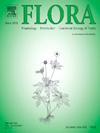生物气候变量沿海拔梯度影响四种仙人掌科植物的种子质量和幼苗特征
IF 1.7
4区 生物学
Q3 ECOLOGY
引用次数: 0
摘要
与海拔高度相关的气候因子差异会导致分布范围较广的物种对当地适应性的自然选择,一些再生特性会随着梯度的变化而变化。大多数仙人掌科物种分布在不同的环境中,主要是山区。随着海拔梯度的增加,环境条件的恶劣程度会影响种子的大小,从而影响幼苗的生长。本研究的主要目的是分析仙人掌属(Gymnocalycium)四个物种不同种群的种子质量、幼苗大小和形状是否与海拔梯度有关,并评估种子质量与生物气候变量之间的关系。研究人员对四种Gymnocalycium(G. andreae、G. erinaceum、G. monvillei和G. mostii)的种群进行了取样;这些种群分布在三个不同的海拔梯度上,每个种群对应一个海拔等级(极端和中间地点)。在每个海拔高度地点采集成熟果实,并测量种子质量和幼苗性状。形状指数是用高度除以宽度计算得出的。数值为 1 表示幼苗呈 "球状",数值增大表示幼苗呈 "柱状"。计算皮尔逊相关系数来分析种子质量和幼苗大小变量之间的关系。线性模型用于分析种子大小和幼苗形状。首先,以海拔高度为预测因子,然后以种子质量为预测因子,从 WorldClim 中提取了 19 个生物气候变量。结果表明,种子质量与苗形指数、苗高和苗宽呈正相关。种群间种子质量的差异可以用物种、种群所在的梯度以及最冷季度的平均气温、最潮湿月份的降水量和最干旱月份的降水量等环境变量来解释。总之,对四个Gymnocalycium物种的种内分析表明,所有物种的幼苗形态与海拔高度的关系相似。然而,每个物种的种子质量随海拔高度的变化也不同。这些发现表明,每个物种都具有独特的特征,使其能够在海拔梯度不同的气候条件下茁壮成长。本文章由计算机程序翻译,如有差异,请以英文原文为准。
Bioclimatic variables affect seed mass and seedling traits of four Gymnocalycium (Cactaceae) species along elevational gradients
Differences in climatic factors associated with elevation can lead to natural selection for local adaptation in species with a wide distribution range, with some regenerative characteristics changing along the gradient. Most Cactaceae species occur in heterogeneous environments, mainly in mountains. The increasing severity of environmental conditions along elevational gradients could affect seed size, influencing seedling growth. The main aims of the study were to analyse whether seed mass, and seedling size and shape are related to elevational gradients in different populations of four species of the genus Gymnocalycium and to evaluate the relationship between seed mass and bioclimatic variables. Populations of four species of Gymnocalycium (G. andreae, G. erinaceum, G. monvillei and G. mostii) were sampled; the populations were located along three different elevation gradients, with each population corresponding to an elevational class (extremes and intermediate sites). At each elevational site, mature fruits were collected and seed mass and seedling traits were measured. A shape index was calculated by dividing height by width. A value of 1 represents 'globose' seedlings, while increasing values indicate that the seedlings become 'columnar'. The Pearson correlation coefficient was calculated to analyse the relationship between seed mass and seedling size variables. Linear models were used to analyse seed size and seedling shape. First, with elevation as a predictor and then for seed mass, the 19 bioclimatic variables were extracted from WorldClim. The results show that seed mass was positively correlated with seedling shape index, and with seedling height and width. Differences in seed mass among populations were explained by the species and the gradient where they lived, as well as by the environmental variables mean temperature of the coldest quarter, precipitation of the wettest month, and precipitation of the driest month. In conclusion, the intraspecific analyses of the four Gymnocalycium species revealed that the seedling shape patterns were similar across all species in relation to elevation. However, seed mass varied with elevation differently for each species. These findings suggest that each species possesses unique characteristics that enable them to thrive in varying climatic conditions along elevational gradients.
求助全文
通过发布文献求助,成功后即可免费获取论文全文。
去求助
来源期刊

Flora
生物-植物科学
CiteScore
3.30
自引率
10.50%
发文量
130
审稿时长
54 days
期刊介绍:
FLORA publishes original contributions and review articles on plant structure (morphology and anatomy), plant distribution (incl. phylogeography) and plant functional ecology (ecophysiology, population ecology and population genetics, organismic interactions, community ecology, ecosystem ecology). Manuscripts (both original and review articles) on a single topic can be compiled in Special Issues, for which suggestions are welcome.
FLORA, the scientific botanical journal with the longest uninterrupted publication sequence (since 1818), considers manuscripts in the above areas which appeal a broad scientific and international readership. Manuscripts focused on floristics and vegetation science will only be considered if they exceed the pure descriptive approach and have relevance for interpreting plant morphology, distribution or ecology. Manuscripts whose content is restricted to purely systematic and nomenclature matters, to geobotanical aspects of only local interest, to pure applications in agri-, horti- or silviculture and pharmacology, and experimental studies dealing exclusively with investigations at the cellular and subcellular level will not be accepted. Manuscripts dealing with comparative and evolutionary aspects of morphology, anatomy and development are welcome.
 求助内容:
求助内容: 应助结果提醒方式:
应助结果提醒方式:


